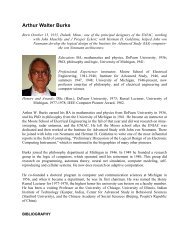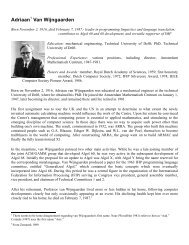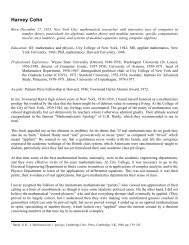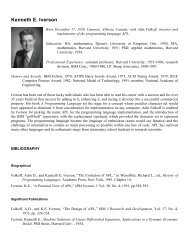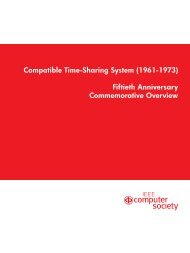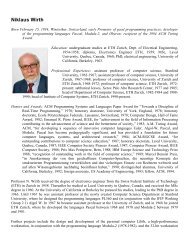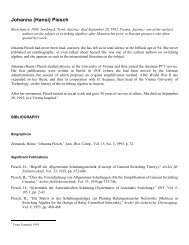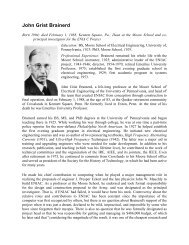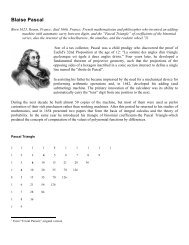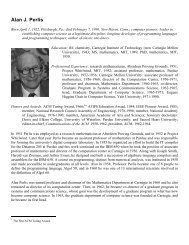- Page 1: A CULTURE OF INNOVATION INSIDER ACC
- Page 4 and 5: About the front cover design For de
- Page 6 and 7: Copyright © 2011 by David Walden a
- Page 9 and 10: Contents Preface and Acknowledgment
- Page 11 and 12: 9 Control Systems R&D at BBN 189 Sh
- Page 13: 20 SIMNET: A Revolution in Distribu
- Page 16 and 17: [xiv] a culture of innovation impor
- Page 19 and 20: About the Authors All of the author
- Page 21: About the Authors [xix] Sciences Di
- Page 24 and 25: [2] part i. founders and the early
- Page 26 and 27: [4] part i. founders and the early
- Page 28 and 29: [6] part i. founders and the early
- Page 30 and 31: [8] part i. founders and the early
- Page 32 and 33: [10] part i. founders and the early
- Page 36 and 37: [14] part i. founders and the early
- Page 38 and 39: [16] part i. founders and the early
- Page 40 and 41: [18] part i. founders and the early
- Page 43 and 44: Chapter 2 A Sketch of the Life of R
- Page 45 and 46: Chapter 3 The ABC’s of BBN From A
- Page 47 and 48: Chapter 3. From Acoustics to Behavi
- Page 49 and 50: Chapter 3. From Acoustics to Behavi
- Page 51 and 52: Chapter 3. From Acoustics to Behavi
- Page 53 and 54: Chapter 3. From Acoustics to Behavi
- Page 55 and 56: Chapter 3. From Acoustics to Behavi
- Page 57 and 58: Chapter 3. From Acoustics to Behavi
- Page 59 and 60: Chapter 3. From Acoustics to Behavi
- Page 61 and 62: CURVES? One. LOOSE ENDS? Two. OBLIQ
- Page 63 and 64: Chapter 3. From Acoustics to Behavi
- Page 65 and 66: Chapter 3. From Acoustics to Behavi
- Page 67 and 68: Chapter 3. From Acoustics to Behavi
- Page 69 and 70: Chapter 3. From Acoustics to Behavi
- Page 71 and 72: Chapter 3. From Acoustics to Behavi
- Page 73 and 74: Chapter 4 Early Years of Basic Comp
- Page 75 and 76: Chapter 4. Early Years of Basic Com
- Page 77 and 78: Chapter 4. Early Years of Basic Com
- Page 79 and 80: Chapter 4. Early Years of Basic Com
- Page 81 and 82: Chapter 4. Early Years of Basic Com
- Page 83 and 84: Chapter 4. Early Years of Basic Com
- Page 85 and 86:
Chapter 4. Early Years of Basic Com
- Page 87 and 88:
Chapter 4. Early Years of Basic Com
- Page 89 and 90:
Chapter 4. Early Years of Basic Com
- Page 91 and 92:
Part II Culture, Business, and Mana
- Page 93 and 94:
Chapter 5 The Way We Were: Aspects
- Page 95 and 96:
Chapter 5. Aspects of the Culture o
- Page 97 and 98:
Chapter 5. Aspects of the Culture o
- Page 99 and 100:
Chapter 5. Aspects of the Culture o
- Page 101 and 102:
5.3 University ties Chapter 5. Aspe
- Page 103 and 104:
Chapter 5. Aspects of the Culture o
- Page 105 and 106:
Chapter 5. Aspects of the Culture o
- Page 107 and 108:
Chapter 5. Aspects of the Culture o
- Page 109:
Chapter 5. Aspects of the Culture o
- Page 112 and 113:
[90] part ii. culture, business, an
- Page 114 and 115:
[92] part ii. culture, business, an
- Page 116 and 117:
[94] part ii. culture, business, an
- Page 118 and 119:
[96] part ii. culture, business, an
- Page 120 and 121:
[98] part ii. culture, business, an
- Page 122 and 123:
[100] part ii. culture, business, a
- Page 124 and 125:
[102] part ii. culture, business, a
- Page 126 and 127:
[104] part ii. culture, business, a
- Page 128 and 129:
[106] part ii. culture, business, a
- Page 130 and 131:
[108] part ii. culture, business, a
- Page 132 and 133:
[110] part ii. culture, business, a
- Page 134 and 135:
[112] part ii. culture, business, a
- Page 136 and 137:
[114] part ii. culture, business, a
- Page 138 and 139:
[116] part ii. culture, business, a
- Page 140 and 141:
[118] part ii. culture, business, a
- Page 142 and 143:
[120] part ii. culture, business, a
- Page 144 and 145:
[122] part ii. culture, business, a
- Page 146 and 147:
[124] part ii. culture, business, a
- Page 148 and 149:
[126] part ii. culture, business, a
- Page 150 and 151:
[128] part ii. culture, business, a
- Page 152 and 153:
[130] part ii. culture, business, a
- Page 154 and 155:
[132] part ii. culture, business, a
- Page 156 and 157:
[134] part ii. culture, business, a
- Page 158 and 159:
[136] part ii. culture, business, a
- Page 161 and 162:
Part III Applying Computer Technolo
- Page 163 and 164:
Chapter 8 Psychology at BBN from th
- Page 165 and 166:
Chapter 8. Psychology at BBN from t
- Page 167 and 168:
Chapter 8. Psychology at BBN from t
- Page 169 and 170:
Chapter 8. Psychology at BBN from t
- Page 171 and 172:
Competitively bid projects Chapter
- Page 173 and 174:
Chapter 8. Psychology at BBN from t
- Page 175 and 176:
Chapter 8. Psychology at BBN from t
- Page 177 and 178:
Chapter 8. Psychology at BBN from t
- Page 179 and 180:
Chapter 8. Psychology at BBN from t
- Page 181 and 182:
Chapter 8. Psychology at BBN from t
- Page 183 and 184:
Chapter 8. Psychology at BBN from t
- Page 185 and 186:
Chapter 8. Psychology at BBN from t
- Page 187 and 188:
Chapter 8. Psychology at BBN from t
- Page 189 and 190:
Chapter 8. Psychology at BBN from t
- Page 191 and 192:
Chapter 8. Psychology at BBN from t
- Page 193 and 194:
Chapter 8. Psychology at BBN from t
- Page 195 and 196:
Chapter 8. Psychology at BBN from t
- Page 197 and 198:
Chapter 8. Psychology at BBN from t
- Page 199 and 200:
8.7 Concluding comment Chapter 8. P
- Page 201 and 202:
Chapter 8. Psychology at BBN from t
- Page 203 and 204:
Chapter 8. Psychology at BBN from t
- Page 205 and 206:
Chapter 8. Psychology at BBN from t
- Page 207 and 208:
Chapter 8. Psychology at BBN from t
- Page 209 and 210:
Chapter 8. Psychology at BBN from t
- Page 211 and 212:
Chapter 9 Control Systems R&D at BB
- Page 213 and 214:
Early Efforts Chapter 9. Control Sy
- Page 215 and 216:
Chapter 9. Control Systems R&D at B
- Page 217 and 218:
Chapter 9. Control Systems R&D at B
- Page 219 and 220:
Chapter 9. Control Systems R&D at B
- Page 221 and 222:
Chapter 9. Control Systems R&D at B
- Page 223 and 224:
Chapter 9. Control Systems R&D at B
- Page 225 and 226:
Chapter 9. Control Systems R&D at B
- Page 227 and 228:
Chapter 9. Control Systems R&D at B
- Page 229 and 230:
Chapter 9. Control Systems R&D at B
- Page 231 and 232:
Chapter 9. Control Systems R&D at B
- Page 233 and 234:
Chapter 9. Control Systems R&D at B
- Page 235 and 236:
Chapter 9. Control Systems R&D at B
- Page 237 and 238:
Chapter 9. Control Systems R&D at B
- Page 239 and 240:
Chapter 9. Control Systems R&D at B
- Page 241 and 242:
Chapter 10 50 Years of Acoustic Sig
- Page 243 and 244:
Chapter 10. Acoustic Signal Process
- Page 245 and 246:
Chapter 10. Acoustic Signal Process
- Page 247 and 248:
Chapter 10. Acoustic Signal Process
- Page 249 and 250:
Chapter 10. Acoustic Signal Process
- Page 251 and 252:
Chapter 10. Acoustic Signal Process
- Page 253 and 254:
Chapter 10. Acoustic Signal Process
- Page 255 and 256:
Chapter 10. Acoustic Signal Process
- Page 257 and 258:
Chapter 10. Acoustic Signal Process
- Page 259 and 260:
Chapter 10. Acoustic Signal Process
- Page 261 and 262:
Chapter 10. Acoustic Signal Process
- Page 263 and 264:
Chapter 10. Acoustic Signal Process
- Page 265:
Chapter 10. Acoustic Signal Process
- Page 268 and 269:
[246] part iii. applying computer t
- Page 270 and 271:
[248] part iii. applying computer t
- Page 272 and 273:
[250] part iii. applying computer t
- Page 274 and 275:
[252] part iii. applying computer t
- Page 276 and 277:
[254] part iii. applying computer t
- Page 278 and 279:
[256] part iii. applying computer t
- Page 280 and 281:
[258] part iii. applying computer t
- Page 282 and 283:
[260] part iii. applying computer t
- Page 284 and 285:
[262] part iii. applying computer t
- Page 287 and 288:
Chapter 12 Medical Applications of
- Page 289 and 290:
Chapter 12. Medical Applications of
- Page 291 and 292:
Chapter 12. Medical Applications of
- Page 293 and 294:
Chapter 12. Medical Applications of
- Page 295 and 296:
Chapter 12. Medical Applications of
- Page 297 and 298:
Chapter 12. Medical Applications of
- Page 299 and 300:
Chapter 12. Medical Applications of
- Page 301:
Chapter 12. Medical Applications of
- Page 304 and 305:
[282] part iii. applying computer t
- Page 306 and 307:
[284] part iii. applying computer t
- Page 308 and 309:
[286] part iii. applying computer t
- Page 310 and 311:
[288] part iii. applying computer t
- Page 312 and 313:
[290] part iii. applying computer t
- Page 314 and 315:
[292] part iii. applying computer t
- Page 316 and 317:
[294] part iii. applying computer t
- Page 318 and 319:
[296] part iii. applying computer t
- Page 320 and 321:
[298] part iii. applying computer t
- Page 322 and 323:
[300] part iii. applying computer t
- Page 324 and 325:
[302] part iii. applying computer t
- Page 326 and 327:
[304] part iii. applying computer t
- Page 328 and 329:
[306] part iii. applying computer t
- Page 330 and 331:
[308] part iii. applying computer t
- Page 332 and 333:
[310] part iii. applying computer t
- Page 334 and 335:
[312] part iii. applying computer t
- Page 336 and 337:
[314] part iii. applying computer t
- Page 338 and 339:
[316] part iii. applying computer t
- Page 340 and 341:
[318] part iii. applying computer t
- Page 342 and 343:
[320] part iii. applying computer t
- Page 344 and 345:
[322] part iii. applying computer t
- Page 346 and 347:
[324] part iii. applying computer t
- Page 348 and 349:
[326] part iii. applying computer t
- Page 350 and 351:
[328] part iii. applying computer t
- Page 352 and 353:
[330] part iii. applying computer t
- Page 354 and 355:
[332] part iii. applying computer t
- Page 356 and 357:
[334] part iii. applying computer t
- Page 358 and 359:
[336] part iii. applying computer t
- Page 360 and 361:
[338] part iii. applying computer t
- Page 362 and 363:
[340] part iii. applying computer t
- Page 364 and 365:
[342] part iii. applying computer t
- Page 366 and 367:
[344] part iii. applying computer t
- Page 368 and 369:
[346] part iii. applying computer t
- Page 370 and 371:
[348] part iii. applying computer t
- Page 372 and 373:
[350] part iii. applying computer t
- Page 375 and 376:
Chapter 14 Speech Processing at BBN
- Page 377 and 378:
Chapter 14. Speech Processing at BB
- Page 379 and 380:
Chapter 14. Speech Processing at BB
- Page 381 and 382:
Chapter 14. Speech Processing at BB
- Page 383 and 384:
Chapter 14. Speech Processing at BB
- Page 385 and 386:
Chapter 14. Speech Processing at BB
- Page 387 and 388:
Chapter 14. Speech Processing at BB
- Page 389 and 390:
Chapter 14. Speech Processing at BB
- Page 391 and 392:
Chapter 14. Speech Processing at BB
- Page 393 and 394:
Chapter 14. Speech Processing at BB
- Page 395 and 396:
Chapter 14. Speech Processing at BB
- Page 397 and 398:
Chapter 14. Speech Processing at BB
- Page 399 and 400:
Chapter 14. Speech Processing at BB
- Page 401 and 402:
Chapter 14. Speech Processing at BB
- Page 403 and 404:
Chapter 15 Natural-Language Underst
- Page 405 and 406:
Chapter 15. Natural-Language Unders
- Page 407 and 408:
Chapter 15. Natural-Language Unders
- Page 409 and 410:
Chapter 15. Natural-Language Unders
- Page 411 and 412:
Chapter 15. Natural-Language Unders
- Page 413 and 414:
Chapter 15. Natural-Language Unders
- Page 415 and 416:
Chapter 15. Natural-Language Unders
- Page 417 and 418:
Chapter 15. Natural-Language Unders
- Page 419 and 420:
Chapter 15. Natural-Language Unders
- Page 421:
Chapter 15. Natural-Language Unders
- Page 424 and 425:
[402] part iii. applying computer t
- Page 426 and 427:
[404] part iii. applying computer t
- Page 428 and 429:
[406] part iii. applying computer t
- Page 430 and 431:
[408] part iii. applying computer t
- Page 432 and 433:
[410] part iii. applying computer t
- Page 434 and 435:
[412] part iii. applying computer t
- Page 437 and 438:
Part IV Developing Computer Technol
- Page 439 and 440:
Chapter 17 Data Networking @ BBN St
- Page 441 and 442:
Chapter 17. Data Networking @ BBN [
- Page 443 and 444:
Chapter 17. Data Networking @ BBN [
- Page 445 and 446:
Chapter 17. Data Networking @ BBN [
- Page 447 and 448:
Chapter 17. Data Networking @ BBN [
- Page 449 and 450:
Chapter 17. Data Networking @ BBN [
- Page 451 and 452:
Chapter 17. Data Networking @ BBN [
- Page 453 and 454:
Chapter 17. Data Networking @ BBN [
- Page 455 and 456:
Chapter 17. Data Networking @ BBN [
- Page 457 and 458:
Chapter 17. Data Networking @ BBN [
- Page 459 and 460:
Chapter 17. Data Networking @ BBN [
- Page 461 and 462:
Chapter 17. Data Networking @ BBN [
- Page 463 and 464:
17.7 What has BBN’s role been? Ch
- Page 465 and 466:
Chapter 17. Data Networking @ BBN [
- Page 467 and 468:
Chapter 17. Data Networking @ BBN [
- Page 469 and 470:
Chapter 17. Data Networking @ BBN [
- Page 471:
Chapter 17. Data Networking @ BBN [
- Page 474 and 475:
[452] part iv. developing computer
- Page 476 and 477:
[454] part iv. developing computer
- Page 478 and 479:
[456] part iv. developing computer
- Page 480 and 481:
[458] part iv. developing computer
- Page 482 and 483:
[460] part iv. developing computer
- Page 484 and 485:
[462] part iv. developing computer
- Page 486 and 487:
[464] part iv. developing computer
- Page 488 and 489:
[466] part iv. developing computer
- Page 490 and 491:
[468] part iv. developing computer
- Page 492 and 493:
[470] part iv. developing computer
- Page 494 and 495:
[472] part iv. developing computer
- Page 496 and 497:
[474] part iv. developing computer
- Page 498 and 499:
[476] part iv. developing computer
- Page 500 and 501:
[478] part iv. developing computer
- Page 502 and 503:
[480] part iv. developing computer
- Page 504 and 505:
[482] part iv. developing computer
- Page 506 and 507:
[484] part iv. developing computer
- Page 508 and 509:
[486] part iv. developing computer
- Page 510 and 511:
[488] part iv. developing computer
- Page 512 and 513:
[490] part iv. developing computer
- Page 514 and 515:
[492] part iv. developing computer
- Page 516 and 517:
[494] part iv. developing computer
- Page 518 and 519:
[496] part iv. developing computer
- Page 520 and 521:
[498] part iv. developing computer
- Page 522 and 523:
[500] part iv. developing computer
- Page 524 and 525:
[502] part iv. developing computer
- Page 526 and 527:
[504] part iv. developing computer
- Page 528 and 529:
[506] part iv. developing computer
- Page 530 and 531:
[508] part iv. developing computer
- Page 532 and 533:
[510] part iv. developing computer
- Page 534 and 535:
[512] part iv. developing computer
- Page 536 and 537:
[514] part iv. developing computer
- Page 538 and 539:
[516] part iv. developing computer
- Page 540 and 541:
[518] part iv. developing computer
- Page 542 and 543:
[520] part iv. developing computer
- Page 544 and 545:
[522] part iv. developing computer
- Page 546 and 547:
[524] part iv. developing computer
- Page 548 and 549:
[526] part iv. developing computer
- Page 550 and 551:
[528] part iv. developing computer
- Page 552 and 553:
[530] part iv. developing computer
- Page 554 and 555:
[532] part iv. developing computer
- Page 556 and 557:
[534] part iv. developing computer
- Page 558 and 559:
[536] part iv. developing computer
- Page 560 and 561:
[538] part iv. developing computer
- Page 562 and 563:
[540] part iv. developing computer
- Page 564 and 565:
[542] part iv. developing computer
- Page 566 and 567:
[544] part iv. developing computer
- Page 568 and 569:
[546] part iv. developing computer
- Page 570 and 571:
[548] part iv. developing computer
- Page 572 and 573:
[550] part iv. developing computer
- Page 574 and 575:
[552] part iv. developing computer
- Page 576 and 577:
[554] part iv. developing computer
- Page 578 and 579:
[556] part iv. developing computer
- Page 580 and 581:
[558] part iv. developing computer
- Page 583:
The fonts usedin the main text of t






